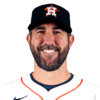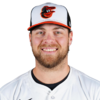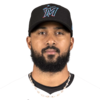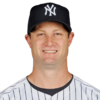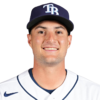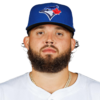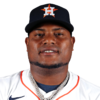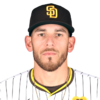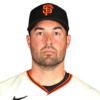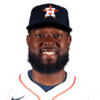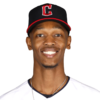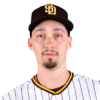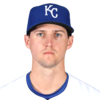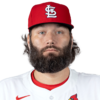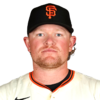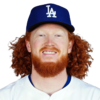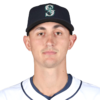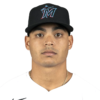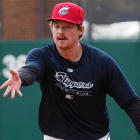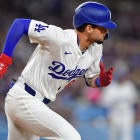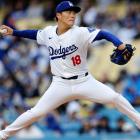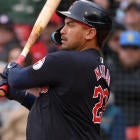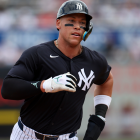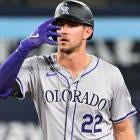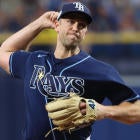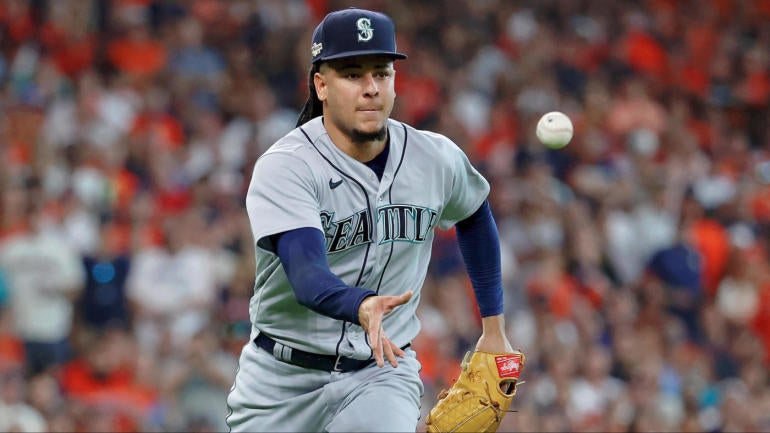
The further removed we are from it, the more the juiced ball era seems like upside-down town.
Remember how for a hot minute there, starting pitcher was the make-or-break asset in Fantasy Baseball -- perhaps even the only asset that mattered when the juiced ball was at its juiciest? It defied decades of conventional wisdom, but it was a logical response to the way the game was trending. Much of the pitcher pool had been rendered ineffective by a ball that carried too easily while the hitter pool was producing All-Star sluggers at the drop of a hat.
Here's the thing: that "hot minute" lasted about six years. Try recapturing your mindset for anything six years past, much less your approach to Fantasy Baseball. Some of you might have no frame of reference for it at all.
I'll have more to say about it in the coming months, but this first look at the starting pitcher rankings offers a foretaste of what's to come. It's quality upon quality, with so many alike options that ranking them is basically a matter of personal preference. That goes for 1 through 7, but it goes just as much for 8 through .. what, 25? Is Zack Wheeler that much better than Joe Musgrove? Some might look at Kyle Wright at 32 and wonder why he's being left out. I agree it feels wrong!
Even 36 through 40 are pitchers we'd all be excited to draft, I dare say. And consider some of those left out. Up-and-comers like Nick Lodolo, Hunter Greene and Joe Ryan. Questionable breakouts like Merrill Kelly, Miles Mikolas and Martin Perez. Bounce-back candidates like Charlie Morton, Jose Berrios and Lucas Giolito. Injury recoverees like Chris Sale, Freddy Peralta and Jack Flaherty. Still others who we would have been inclined to reach for in the not-so-distant past.
The amount of parsing required of me here goes to show how redundant an early investment in starting pitcher has become. And just like that, Fantasy Baseball has recaptured its classic feel.
Note that the focus here is standard 5x5 scoring (such as Rotisserie leagues), but scroll a little further and you'll see my rankings for points leagues.
| 1 |
Justin Verlander
Houston Astros SP
|
| You could make the case for any of my top seven as No. 1 without getting much guff from me, but Verlander I think offers the best combination of dominance and durability, even at age 40. | |
| 2 |
Max Scherzer
New York Mets SP
|
| Here's to the old guys! Scherzer's IL stints the past couple years have had nothing to do with his arm, which appears ageless. He remains as reliable of a Cy Young candidate as there is. | |
| 3 |
Corbin Burnes
Milwaukee Brewers SP
|
| Though 2022 was a step back for Burnes overall, largely due to a stretch in the second half when he became curiously hittable, he showed he could extend himself beyond 200 innings, cementing his ace standing. | |
| 4 |
Sandy Alcantara
Miami Marlins SP
|
| Volume-wise, Alcantara is in a class of his own, lasting at least eight innings (not six, not seven, but eight) in 14 of his 32 starts. That's enough to move him to the top spot in points leagues, but his modest strikeout rate and likelihood of ERA regression hold him back in 5x5 scoring. | |
| 5 |
Gerrit Cole
New York Yankees SP
|
| The time for reflexively ranking Cole No. 1 is past. He's the reigning MLB strikeout leader and still brings the heat, but it's clear now his vulnerability to the long ball makes him a bigger ERA liability than anyone else I might consider for that top spot. | |
| 6 |
Jacob deGrom
New York Mets SP
|
| Part of me wants to rank deGrom No. 1 given that he ended the year healthy and is still clearly the best inning for inning, but how many innings can we honestly expect from him? He has about a season's worth since 2019. | |
| 7 |
Shane McClanahan
Tampa Bay Rays SP
|
| The 25-year-old looked like he had climbed to the top of the pitching heap for the first 4 1/2 months, combining a superlative whiff rate with elite ground-ball skills, but he didn't look right after missing time late in the year with a shoulder impingement. It's enough to give me pause. | |
| 8 |
Brandon Woodruff
Milwaukee Brewers SP
|
| Woodruff still has yet to meet the 180-inning threshold that's sort of the minimum expectation for an ace, but his numbers the past three years are about as consistent as you'll find. An IL stint for an ankle injury seemed to snap him out of his early-season slumber, resulting in a 2.38 ERA over his final 18 starts. | |
| 9 |
Zack Wheeler
Philadelphia Phillies SP
|
| Wheeler came close to repeating the ratios that made him the NL Cy Young runner-up in 2021, which is particularly impressive given that an offseason shoulder issue delayed his start to spring training and compromised his velocity early. He's achieved the dependability you want from an ace. | |
| 10 |
Aaron Nola
Philadelphia Phillies SP
|
| Nola rebounded from a fluky 4.63 ERA as expected, but this time it was bad win-loss luck holding him back. He still ranked fourth in the majors in strikeouts, second in innings and second in walks per nine. | |
| 11 |
Carlos Rodon
San Francisco Giants SP
|
| Rodon didn't look right to end 2021 but came back strong this year to show the breakthrough was no fluke, even setting a career high for innings in what may turn out to be his only season with the Giants. Questions of durability remain, but not effectiveness. | |
| 12 |
Dylan Cease
Chicago White Sox SP
|
| The Lalo Salamanca look-alike has overpowering stuff but still struggles to throw strikes, and I worry that a 14-start stretch with a 0.66 ERA in the middle of the season may create unrealistic expectations for him. He's good, but flawed. | |
| 13 |
Shane Bieber
Cleveland Guardians SP
|
| Bieber had to make do with reduced velocity after losing most of 2021 to a shoulder injury, and while his strikeouts suffered, he more or less pitched like an ace. A top-10 finish is still within reach even if a top-five finish probably isn't. | |
| 14 |
Alek Manoah
Toronto Blue Jays SP
|
| Like the latest rendition of Bieber, Manoah is less of a bat-misser than a strike-thrower who piles up innings -- a profile that rates better in points leagues, frankly. Of course, his 2.24 ERA says otherwise, but all the ERA estimators hint of regression, perhaps by as much as a run. | |
| 15 |
Spencer Strider
Atlanta Braves SP
|
| Strider became the game's must-see pitcher soon after joining the rotation in late May, and his 13.8 K/9 and 1.83 FIP were by far the best for any pitcher with at least 100 innings. He still has to prove he can take on a full workload and hold up to repeat viewings, but he's the only pitcher in this top 40 who's also RP-eligible. | |
| 16 |
Shohei Ohtani
Los Angeles Angels DH
|
| If you were convinced after 2021 that Ohtani is better as a hitter than a pitcher, 2022 might have you rethinking your stance. For as good as he proved to be, winning 15 games with a 2.33 ERA and 219 strikeouts, his impact potential remains limited by him starting every sixth game rather than every fifth. | |
| 17 |
Julio Urias
Los Angeles Dodgers SP
|
| Urias went from having 20 wins in 2021 to having a 2.16 ERA in 2022 (making it 1.84 over his final 21 starts). His standout skill is simply limiting hard contact, which generally isn't our go-to for evaluating pitchers, but he's sustained it over enough years to trust in it. His supporting cast certainly bolsters his case. | |
| 18 |
Max Fried
Atlanta Braves SP
|
| Fried excels in the same areas Urias does, consistently delivering in ERA and wins despite underwhelming strikeout rates and innings totals. It makes them decidedly second-tier, but there's something to be said for reliability. | |
| 19 |
Yu Darvish
San Diego Padres SP
|
| The biggest knock on Darvish may well be reliability. He's coming off his best season in a decade, but it came on the heels of a 2021 second half so bad (6.16 ERA) that the 36-year-old looked like he may be spent. Still, the reward outweighs the risk here. | |
| 20 |
Luis Castillo
Seattle Mariners SP
|
| Castillo turned in the best season of his career right about the point when it seemed like he might never live up to his ace promise. It took some tweaks to his arsenal and a favorable venue change to get him there, which may be enough, but the shaky track record gives me pause still. | |
| 21 |
Kevin Gausman
Toronto Blue Jays SP
|
| On the one hand, no pitcher had a higher swinging-strike rate than Gausman in 2022, but on the other hand, only one pitcher had higher than his .363 BABIP. It's a strange dichotomy that resulted in an inflated ERA and especially WHIP, but because it mostly afflicted him at home, there may be something to it. | |
| 22 |
Zac Gallen
Arizona Diamondbacks SP
|
| Fair to say Gallen put his 2021 elbow troubles behind him with a career-best 2022 in which he got his walks under control and had a scoreless streak of over 44 innings at one point. Then again, his swinging-strike sputtered for a second straight year, and he outperformed all the ERA estimators. Jury's still out, I say. | |
| 23 |
Framber Valdez
Houston Astros SP
|
| A fascinating pitcher who's always gotten more love in points leagues because of his ability to pile on innings (his three complete games were second only to Alcantara's six), Valdez closed the gap between the two formats with 17 wins and a sub-3.00 ERA. HIs extreme ground-ball tendencies will keep the WHIP kind of high. | |
| 24 |
Joe Musgrove
San Diego Padres SP
|
| Musgrove had a dominant first half and a shaky second half, ending with numbers very close to what he put up in 2021. It's fair to assume, then, that that's who he is -- a not-quite-ace who makes up for modest strikeout skills by holding together for 180 innings. | |
| 25 |
Robbie Ray
Seattle Mariners SP
|
| For all the volatility, Ray's follow-up to his Cy Young campaign was still one of his better seasons -- maybe even his second-best. Introducing a sinker helped to stabilize things midseason, but then the whiffs dried up in September, making it hard to know exactly what you're getting next year. | |
| 26 |
Cristian Javier
Houston Astros SP
|
| Javier was No. 1 in opponent batting average, which may seem like good fortune, but he was also No. 1 in fly-ball rate, which tracks. He was so dominant after rejoining the rotation in May that his bullpen days are surely behind him, so his 2023 prospects are mostly a matter of him building up innings and avoiding the long ball. | |
| 27 |
Triston McKenzie
Cleveland Guardians SP
|
| McKenzie is much like Javier in that he thrives on limiting hits by reducing fly balls. The home run risk is high, but it may work out well enough now that the juiced ball is gone. Still, McKenzie doesn't get strikeouts and the rate Javier does and did just pile on a bunch of innings for a skinny guy. | |
| 28 |
Clayton Kershaw
Los Angeles Dodgers SP
|
| At this stage of his career, particularly given how easy the Dodgers have it during the regular season (I'm just presuming he'll be back), you shouldn't count on more than 140 innings from Kershaw. They'll be quality, ace-like innings, but you'll have to do without when he's sidelined by whatever he's sidelined by (probably his back). | |
| 29 |
Tyler Glasnow
Tampa Bay Rays SP
|
| Glasnow's career high in innings as a major-leaguer is 111 2/3, so even though he looked great after returning from Tommy John surgery in late September and has a 2.75 ERA, 0.97 WHIP and 12.7 K/9 dating back to 2019, investing more than this in him is as pie-and-the-sky as it gets. | |
| 30 |
Blake Snell
San Diego Padres SP
|
| Snell has taken us on such a ride since his Cy Young 2018 season that it's understandable why you might never trust him again, but the final three months of 2022 represented his longest stretch of sustained success since then, resulting in a 2.53 ERA, 1.11 WHIP and 12.9 K/9. Even at his best, efficiency is an issue. | |
| 31 |
Logan Gilbert
Seattle Mariners SP
|
| The end result for Gilbert was satisfactory, with the workload he took on in his first full year being especially encouraging, but you'd like a young power arm to miss more bats than he did. He found another gear in September, though, and I think the tendency will be to see the glass half full. | |
| 32 |
Kyle Wright
Atlanta Braves SP
|
| This may seem low for the majors' only 20-game winner, and certainly, there are things to like about Wright, whose power curveball has made him a premier ground-ball pitcher with a little something working in the strikeout column. But only a little something, which points to a modest ceiling if the wins aren't there. | |
| 33 |
Lance Lynn
Chicago White Sox SP
|
| A quick glance at Lynn's 3.99 ERA would suggest the burly 35-year-old is losing his touch, but his struggles were limited to his first nine turns back from a torn meniscus, when he put together a 6.42 ERA as compared to a 2.43 ERA over his final 12 turns. His swinging-strike rate was a career best. | |
| 34 |
Luis Severino
New York Yankees SP
|
| Severino's first year back from an especially lengthy Tommy John absence was mostly a success, though durability remains a major concern given the two months he missed with a lat injury. It would also be nice to see him lean on his best pitch, the slider, like he did before the elbow injury. | |
| 35 |
Logan Webb
San Francisco Giants SP
|
| Webb enjoyed a strong follow-up to his breakthrough 2021 ... except that his K/9 rate dropped from 9.6 to 7.6. You'd think his other numbers would follow suit, but because Webb throws strikes and keeps the ball on the ground, apparently not. He now profiles better for points scoring than 5x5, though. | |
| 36 |
Nestor Cortes
New York Yankees SP
|
| Cortes' oddball profile has now been proven to work over a full season, and if you just look at the metrics without fixating on the stuff (or lack thereof) behind them, he rates out well, the one red flag being a high fly-ball rate. He'd rank higher if he wasn't pulled before six innings more than half the time. | |
| 37 |
Tony Gonsolin
Los Angeles Dodgers SP
|
| Gonsolin and Cortes profile similarly, both using fly balls to keep opponent batting average to a minimum but also struggling to deliver a workload benefitting their ERA. Gonsolin appears to be the lesser strikeout pitcher of the two and also the more susceptible to injury. | |
| 38 |
Dustin May
Los Angeles Dodgers SP
|
| If a GIF-worthy arsenal was all that mattered, May would be a first-round pick, his sinker, cutter and curveball generating such movement at such velocities that it's easy to be taken by flights of fancy. But he's proven very little across four major-league seasons and was kind of shaky in his return from Tommy John late this year. | |
| 39 |
George Kirby
Seattle Mariners SP
|
| The end result of Kirby's rookie season is certainly cause for enthusiasm, particularly given his top prospect pedigree, but the way he came about those numbers is kind of a head-scratcher. It was basically just a killer fastball and elite control, so his future prospects may depend on him developing a better secondary arsenal. | |
| 40 |
Jesus Luzardo
Miami Marlins SP
|
| It's all about the secondary arsenal for Luzardo, even though the preseason hype was mostly tied to improved fastball velocity. That improvement basically went away after a 2 1/2-month absence for a strained forearm, but the results were nonetheless better after returning, suggesting the breakthrough has come if he can only stay on the mound. | |
What changes in points leagues?
1. Sandy Alcantara, Marlins
2. Justin Verlander, free agent (player option)
3. Max Scherzer, Mets
4. Corbin Burnes, Brewers
5. Gerrit Cole, Yankees
6. Jacob deGrom, Mets
7. Shane McClanahan, Rays
8. Brandon Woodruff, Brewers
9. Zack Wheeler, Phillies
10. Aaron Nola, Phillies
11. Shane Bieber, Guardians
12. Alek Manoah, Blue Jays
13. Carlos Rodon, Giants
14. Dylan Cease, White Sox
15. Spencer Strider, Braves
16. Julio Urias, Dodgers
17. Max Fried, Braves
18. Yu Darvish, Padres
19. Framber Valdez, Astros
20. Shohei Ohtani, Angels
21. Luis Castillo, Mariners
22. Kevin Gausman, Blue Jays
23. Zac Gallen, Diamondbacks
24. Joe Musgrove, Padres
25. Robbie Ray, Mariners
26. Cristian Javier, Astros
27. Triston McKenzie, Guardians
28. Clayton Kershaw, Dodgers
29. Logan Gilbert, Mariners
30. Kyle Wright, Braves
31. Logan Webb, Giants
32. Tyler Glasnow, Rays
33. Blake Snell, Padres
34. Lance Lynn, White Sox
35. Luis Severino, Yankees
36. Nestor Cortes, Yankees
37. Tony Gonsolin, Dodgers
38. Dustin May, Dodgers
39. George Kirby, Mariners
40. Jesus Luzardo, Marlins







